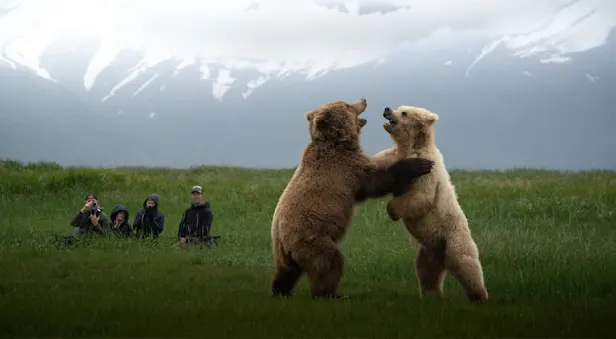
Know Before You Go


Red Fox Facts | Alaska Wildlife Guide
Red foxes can be found throughout Alaska, except for a few islands in the southeast. With warming temperatures, their range is expanding farther north, into arctic fox territory, and where these two overlap the red fox is dominant.
Physical Characteristics
Despite their name, red foxes’ color can range from deep red to grizzled grey, to an extremely light yellow. But there are a few characteristics that can help identify red foxes regardless of their color phase: look for the black “socks” on their legs, white cheek patches and a white tip on the end of their bushy tail. The nose of the foxes found on cliffs in the high Arctic areas are more pointed than those of coyotes, and they are significantly smaller, only weighing 8 to 15 pounds.
Habitat & Feeding Habits
Red foxes become accustomed to humans, and can be found living in suburban neighborhoods as long as they can find places to hide and breed, like below decks. They live in every state in the U.S. except for Hawaii, and on every continent except Antarctica. In the wild, they prefer edge habitats where they can hunt voles, birds, eggs, lizards and other small prey in open meadows, and then retreat to the woods for protection.
Behavior & Home Range
Red foxes are shy and elusive creatures, preferring to roam the fields and forests at night. These adaptable members of the canine family can also be found near marshes, prairies, beaches and wandering the tundra. They are solitary animals and defend their home ranges, which average approximately 730 acres in size and are frequently bounded by natural barriers such as rivers. Males have larger ranges than females, while social status and food availability also contribute to the sizes and shapes of home ranges.
Breeding & Young
Although red foxes are typically not aggressive creatures, they do engage in skirmishes at the onset of the breeding season in mid-January. A dominant male, after fending off other suitors, will mate with a receptive vixen. The then inseparable pair traverses the woodlands and meadows in search of a den. As they travel the countryside, they look for a burrow on a stream bank or hillside that faces south.
Females typically give birth to four pups 52 days after conception in mid-March. The vixen stays in the den with her young for their first few days of life while her mate forages for food. She then begins to leave the den for short periods of time to hunt. During this time, her pups are left vulnerable, at risk of predation by wolves.
Pups are nourished on a diet of milk supplemented with semi-digested meat, which is provided by their parents. At 3 months, the young are weaned and they begin to learn how to hunt under the watchful eye of their mother. Playful interludes help the pups hone their speed and agility—skills vital to their survival. By the fall, the young foxes' hunting ability is well developed, and in early winter the family separates, each member setting out to establish a new home range.
See Red Foxes on These Alaska Adventures

Grizzly Ship Photo Expedition: Kodiak to Katmai
Based aboard our private small ship, just eight guests photograph brown bears in the roadless Katmai wilderness, going ashore with an expert bear naturalist and photography pro who knows these animals intimately.































